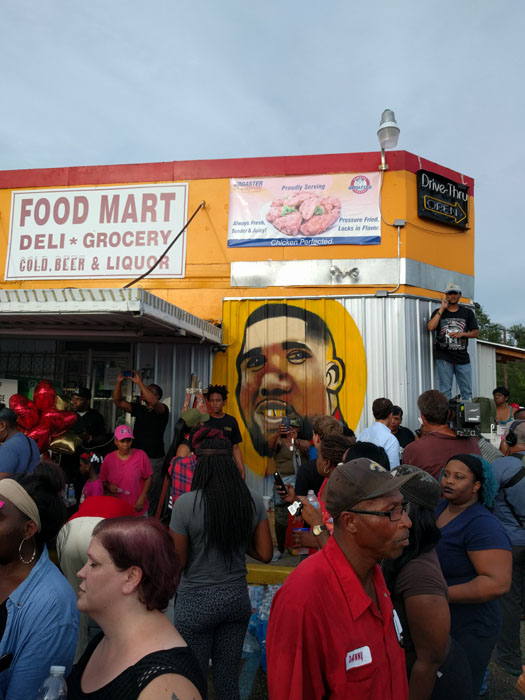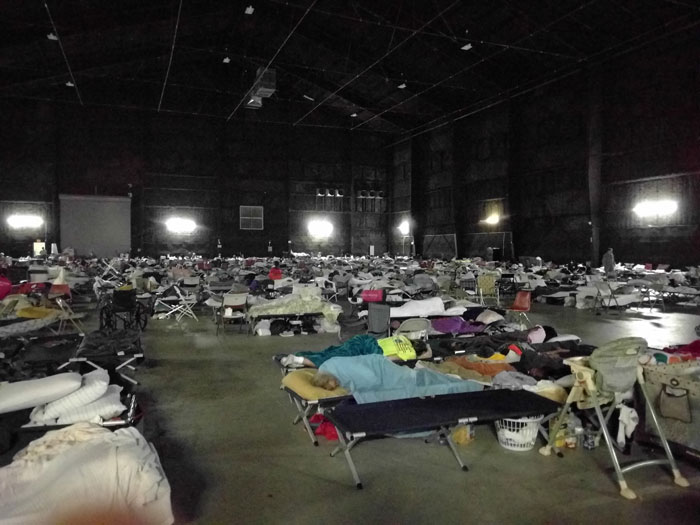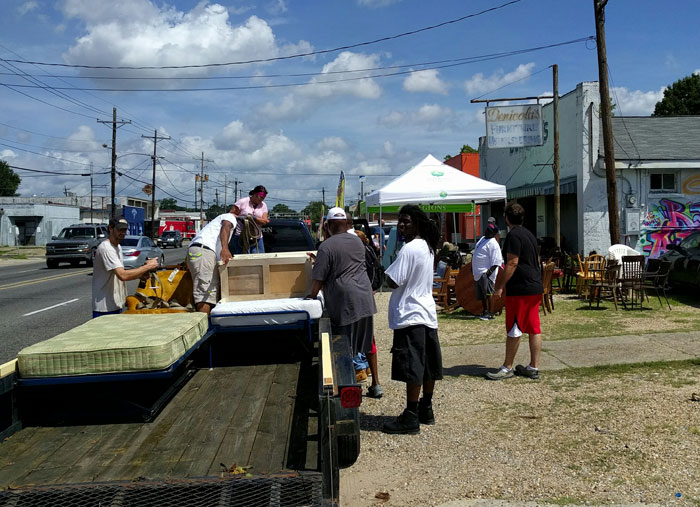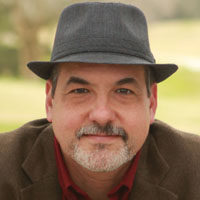
Warning: Contains graphic footage of my earnest, perplexed, fearful, middle-class, middle-aged, white, privileged ass.
This has been a summer of surprises in my city, Baton Rouge: a black man killed by police, sparking a local and national firestorm; six police officers shot by a black man, three fatally; floodwaters engulfing the city without warning.
Oh, and me, sitting in the grass by my broken bike in North Baton Rouge on a July afternoon, nursing a sore knee and trying to comprehend what had just happened.
And maybe—just maybe—in the middle of all that, an opportunity.
On July 6, I woke up, checked my newsfeed and realized that my city had become a national flashpoint. With the Alton Sterling shooting, the blood-soaked dirty laundry of our country’s relationship between race and policing was strewn across our front lawn for the whole country to see.
I got word of a vigil that evening to be held at the Triple S convenience store where Alton had died. I thought, “I can do that.” I could offer my profound sympathy and the solidarity of my presence.
I wanted to let folks see it in my eyes: I’m so sorry this happened. I’m here. I love you.

I could go there.
But what was the anxious feeling rumbling in my stomach? Ah, fear.
Our city is heavily segregated. The vigil wasn’t at a “neutral” ground like City Hall or the State Capitol—it was in the heart of North Baton Rouge—an overwhelmingly black, economically depressed area. Tensions were running high, and I’d be a self-invited guest in the home of people who had many reasons for not being too happy with folks who look like me.
Plus, I didn’t know anyone from that neighborhood. I knew some people planning to attend, but I would be making the trip solo, without a posse of friends to vouch for my allyship along the way. It was just going to be my 6’1,” 215 pounds of middle-aged whiteness, riding my bike for the first time north of Florida Boulevard.
Friends. My mind wandered over some of my friends who are black, particularly the men. If they walked unaccompanied down a street in my white middle-class sub-division, I was pretty sure the Nextdoor social app would light up like Christmas with posts by the neighborhood vigilantes.
Oh wait. This fear I was feeling as I contemplated this one journey? This was a pale reflection of the anxiety my black friends experienced every single day as they moved through the streets, sidewalks, office towers, job interviews, loan departments and traffic stops of white privilege. So now I had to do it. If I could help to make more of the world more welcoming to them, then it would be worth it. And any further doubt evaporated when I opened Facebook and saw a friend’s post:
BR is a city of all colors. If you are willing to go downtown but not willing to go to NBR, it will not do. There needs to be white faces there tonight to show that ALL people support change.
That settled it. I threw my bike into the back of my SUV and drove to the YMCA, which sits right at the dividing line between North and South—black and white—Baton Rouge. I pulled my bike out of the car and started in the direction of the vigil, clutching a dozen roses in one hand.
Since Foster Drive was jammed with traffic, I took the quieter, more residential 49th Street that runs parallel to it. I passed yards with circles of old black men cracking open beers and porches of women fanning themselves in the oppressive heat. I waved at anyone who caught my eye. A few nodded or waved back. I could feel my anxiety easing.
At the first major intersection, I stopped to consult my phone map. A sleek black Dodge Charger with tinted windows pulled up next to me. The passenger side window slowly lowered to reveal a 20-something dread-locked and tattooed African-American man, looking directly at me.
He smiled. “Hey Man, you need some directions?”
I exhaled. “Thanks. I appreciate it. I’m trying to get to the vigil for Alton.” He got me pointed in the right direction. I thanked him again. He took off, and I turned down Gus Young Avenue. Out of the corner of my eye, I saw a group of three young black men on the opposite side of the road. One of them gestured at me and yelled something, but I couldn’t hear him. It didn’t sound friendly, so I just nodded and kept pedalling.
It was about a half a block further on that it happened. Out of nowhere, I felt a heavy thud on the back of my neck and in the next moment I was lying in the grass on top of my bike. I rolled over to see one of the men sprinting in the opposite direction. The others had disappeared.
I wanted to call after him, but words escaped me. After the initial shock, I felt some sadness and discomfort, but not any anger. It wasn’t about me personally—just what the color of my skin represented for him. In that moment—during those tense and charged hours—defending his turf may have felt like the only way he could exercise some self-determination in a game that seemed increasingly stacked against him and his community. And, underneath his anger was probably fear.
He was as afraid of me as I was of him—and we were both caught in something way bigger than either one of us.
I sat for a moment to catch my breath and survey the damage. My handlebars were twisted 90 degrees and fragments of my former light cover glistened in the fading sunlight. Fortunately, my glasses landed in the grass intact. I had a big scrape on my knee and a couple of gouges in my ankle, but that was it. However, it appeared that I would be walking the rest of the way.
Nervous and limping, I made it to the corner and then down the sidewalk of crowded Foster Drive to the vigil without further incident. I chained my bike to a telephone pole and laid my roses at the makeshift shrine where a spray-painted mural of Alton was taking form. I stood among the hundreds gathered in the summer swelter as community and religious leaders, members of Alton’s family and the store owner addressed us passionately.
I felt a little awkward. I wanted to be respectful but not presumptive. Nodding when everyone made the black power salute, but not joining in, because it’s not my gesture to make. Trying not to unconsciously gravitate toward the other white folks, who made up about 10% of the crowd. Striving to quell the occasional surge of anxiety, as my mind drifted toward what might happen if the wrong person yelled the wrong thing.
At one point, a young black woman gently touched my arm: “Excuse me, Sir, your leg is bleeding.”
“Yeah, I know. Thanks. It’s all right.”
My guess is that my narrative of what happened there wasn’t as stark as that of most attendees—and maybe that’s primarily a symptom of my white privilege. I had questions. Things happened before the height of action depicted in the viral videos, starting with the call to police dispatch about a man dressed like Alton brandishing a gun. At the same time, the lack of body cam footage and the seized store video were extremely troubling, if not outright damning. At a bare minimum, I had no doubt that training in de-escalation tactics and better community policing practices could have helped to avoid the tragic outcome. I mean, everyone in that area knew Alton.
And six shots? Six?
That was pure adrenalized fear, stoked by historical and systemic racism. We could do a lot better.
After the speeches, I found my friend who offered to lock my bike up in her warehouse which sits next to the parking lot where Alton died. Then, she gave me a ride back to my car. I drove home and, once inside, allowed myself to lose it a bit, shaking out any residual shock and trauma I was still holding. I spent the rest of the evening self-medicating with antiseptic for my wounds and deep-fried comfort food and ice cream for my soul.
Much has happened since that day. Philando Castile. More vigils and protests. Police in riot gear. The mass arrests. The police shootings in Dallas and Baton Rouge. The high-profile funerals. The outpourings of donations and expressions of support for the Sterling family and those of the slain officers.
I have been concerned that, with all the attention that the tragic police shootings received, the circumstances of Alton’s death could be overshadowed and forgotten. Energy and effective support for police reform might dissipate, particularly in the white community. At present, the large-scale protests have subsided, replaced by fractious debates in the Baton Rouge Metro Council about a proposed residency requirement for new police officers, as a means to better community policing. Of course, the eventual ruling about the culpability of the police officers involved in Alton’s death hangs like a sword of Damocles over the city. Who knows what response it might spark?
And then, in mid-August the water came. It poured into the city in the form of a 1000-year flood event, and it did not discriminate. Both white and black neighborhoods were devastated. Many Baton Rouge police live in the Denham Springs area, where some of the most widespread damage occurred.
Social media was full of scenes of interracial pathos and striking juxtapositions, including police encounters that didn’t involve riot gear. White and black people wading through the water with their luggage held high. Dark and light hands reaching into the water to pull their neighbors to safety, regardless of color. The Red Cross shelter where I volunteered—several hangar-sized buildings—was a veritable United Nations of survivors and volunteers. Everywhere you looked were Pulitzer-worthy multi-cultural tableaus. The exhausted young black couple crowded onto one cot, with their sleeping toddler in the crib next to them. The old white man, his head resting on a ragged LSU Mike the Tiger cushion. The white EMT trying to help the black woman with no legs into a wheelchair. The elderly white woman profusely thanking the embarrassed-looking black National Guard soldiers.

A couple of days ago, I went back to the Triple S in North Baton Rouge. This time, I rode in my SUV, which was loaded with furniture for a donation drive that my friend was coordinating for flood survivors from her warehouse.
This journey was different. As I drove, I noticed that my anxiety was gone. In its place, I felt a little seed of hope.
Premature? Maybe, but I pray that it is not illusory.
For sure, the affected black communities will have a tougher path to recovery than their white counterparts, because they started off with fewer economic resources and shakier infrastructure. And, let’s face it: white communities tend to attract more dollars for a sustained recovery effort. White privilege will still be a Thing. The historical roots of the white/black divide in Baton Rouge will still be there, and finger-pointing in both directions about the solutions will persist. Our police officers still need formal training in de-escalation, and the model and composition of our police force needs serious review and overhaul. We’re still going to have to bring our best thinking and efforts to solve this.
But, I’m hoping that the needle has moved ever so slightly. That suffering together and helping each other in such an up-close and personal way will make some difference: being caught up in the same floodwaters, rescued in the same boats, seeing each other’s pain, standing in the same food lines. That, in subtle ways we may not be able to articulate, it will be at least be a little easier to bridge that divide.
We’ll be starting from a different place.
Maybe it will help us to be a little less afraid of each other. That’s important, because we are all caught in something way bigger than any of us can handle on our own, and it’s going to take all of us pulling together to get to the other side.
I hope we can go there.

Author: Christopher Kisling
Images: Author’s own / Wikipedia
Editor: Renée Picard






Read 6 comments and reply